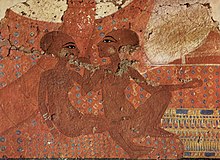Amarna art: Difference between revisions
Rosemoulton (talk | contribs) mNo edit summary |
m →External links: added external link |
||
| Line 36: | Line 36: | ||
==External links== |
==External links== |
||
*[http://www.touregypt.net/featurestories/amarnafigures.htm Amarna figures] |
*[http://www.touregypt.net/featurestories/amarnafigures.htm Amarna figures] |
||
*[http://www.ancientegyptonline.co.uk/amarnaart.html Amarna Art] |
|||
==See also== |
==See also== |
||
Revision as of 18:56, 30 May 2011

The Ancient Egyptian art style known as Amarna Art was a style of art that was adopted in the Amarna Period (i.e. during and just after the reign of Akhenaten in the late Eighteenth Dynasty), and is noticeably different from more conventional Egyptian art styles.
It is characterized by a sense of movement and activity in images, with figures having raised heads, many figures overlapping and many scenes busy and crowded. Also, the human body is portrayed differently in Amarna style artwork than Egyptian art on the whole. For instance, many depictions of Akhenaten's body give him distinctly feminine qualities, such as large hips, prominent breasts, and a larger stomach and thighs. This is a divergence from the earlier Egyptian art which shows men with perfectly chiseled bodies. Faces on reliefs are still shown exclusively in profile.
The illustration of hands and feet was obviously thought to be important. They were shown with long and slender fingers, and great pains were gone to show fingers and finger nails. Flesh was shown as being dark brown, for both males and females (contrasted with the more normal dark brown or red for males and light brown or white for females) – this could merely be convention, or depict the ‘life’ blood. Figures are now shown with both a left and a right foot, contrasting the tradition of being shown with either two left or two right feet.

Tombs
The decoration of the tombs of non-royals is quite different from previous eras. These tombs do not feature any funerary or agricultural scenes, nor do they include the tomb occupant unless he or she is depicted with a member of the royal family. There is an absence of other gods and goddesses, apart from the Aten, the sundisc. However, the Aten does not shine its rays on the tomb owner, only on members of the royal family. There is neither a mention of Osiris nor other funerary figures. There is also no mention of a journey through the underworld. Instead, excerpts from the Hymn to the Aten are generally present.

Sculpture
Sculptures from the Amarna period are set apart from other periods of Egyptian art. One reason is the accentuation of certain features. For instance, an elongation and narrowing of the neck, sloping of the forehead and nose, prominent chin, large ears and lips, spindle-like arms and calves and large thighs, stomachs, and hips.
In a relief of Akhenaten, he is portrayed with his wife and children in an intimate setting. His children appear to be fully grown, only shrunken to appear smaller than their parents. They also have elongated neck and bodies. An unfinished head of a princes from this time, that is currently an artifact of the Tutankhamun, and the golden age of the pharohs exibition, displays a very prominet elongateion to the back of the head.
The head shape may have been an exaggeration of a real head shape, based on the similar shape of the head of Tutankhamun, or a completely false representation of ritulistic reason.
The hands at the end of each ray extending from Aten in the relief are delivering the ankh, which symbolized "life" in the Egyptian culture, to Akhenaten and his wife. The importance of the Sun God Aten is central to much of the Amarna period art, largely because Akhenaten's rule was marked by its monotheistic following of Aten.
In one sculpture of Akhenaten, he has wide hips and a drooping stomach. His lips are thick and his arms and legs are thin and lack muscular tone, unlike his counterparts of other eras in Egyptian artwork. Some scholars suggest that the presentation of the human body as imperfect during the Amarna period is in deference to Aten. Others think Akhenaton suffered from a genetic disorder that caused him to look that way.
Much of the finest work, including the famous Nefertiti bust in Berlin, was found in the studio of the court sculptor Thutmose, and is now in Berlin and Cairo, with some in the Metropolitan Museum of Art, New York.
The period saw the use of sunk relief, previously used for large external reliefs, extended to small carvings, and used for most monumental reliefs. Sunk relief appears best in strong sunlight. This was one innovation that had a lasting effect, as raised relief is rare in later periods.
Architecture
Not many buildings from this period have survived the ravages of later kings, partially as they were constructed out of standard size blocks, known as talatat, which were very easy to remove and reuse. In recent decades, re-building work on later buildings has revealed large number of reused blocks from the period, with the original carved faces turned inwards, greatly increasing the amount of work known from the period.
Temples in Amarna did not follow the traditional Egyptian design and were smaller, with sanctuaries open to the sun, containing large numbers of altars. They had no closing doors. See Great Temple of the Aten, Small Temple of the Aten and the Temple of Amenhotep IV.

